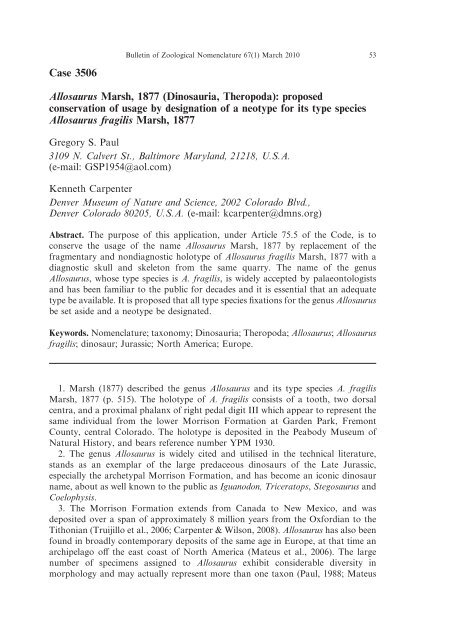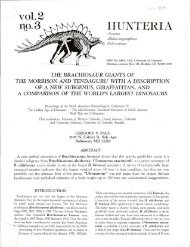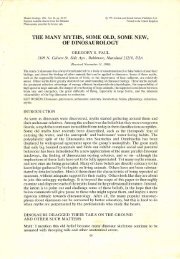Case 3506 Allosaurus Marsh, 1877 (Dinosauria ... - Gregory S. Paul
Case 3506 Allosaurus Marsh, 1877 (Dinosauria ... - Gregory S. Paul
Case 3506 Allosaurus Marsh, 1877 (Dinosauria ... - Gregory S. Paul
Create successful ePaper yourself
Turn your PDF publications into a flip-book with our unique Google optimized e-Paper software.
<strong>Case</strong> <strong>3506</strong><br />
Bulletin of Zoological Nomenclature 67(1) March 2010<br />
<strong>Allosaurus</strong> <strong>Marsh</strong>, <strong>1877</strong> (<strong>Dinosauria</strong>, Theropoda): proposed<br />
conservation of usage by designation of a neotype for its type species<br />
<strong>Allosaurus</strong> fragilis <strong>Marsh</strong>, <strong>1877</strong><br />
<strong>Gregory</strong> S. <strong>Paul</strong><br />
3109 N. Calvert St., Baltimore Maryland, 21218, U.S.A.<br />
(e-mail: GSP1954@aol.com)<br />
Kenneth Carpenter<br />
Denver Museum of Nature and Science, 2002 Colorado Blvd.,<br />
Denver Colorado 80205, U.S.A. (e-mail: kcarpenter@dmns.org)<br />
Abstract. The purpose of this application, under Article 75.5 of the Code, is to<br />
conserve the usage of the name <strong>Allosaurus</strong> <strong>Marsh</strong>, <strong>1877</strong> by replacement of the<br />
fragmentary and nondiagnostic holotype of <strong>Allosaurus</strong> fragilis <strong>Marsh</strong>, <strong>1877</strong> with a<br />
diagnostic skull and skeleton from the same quarry. The name of the genus<br />
<strong>Allosaurus</strong>, whose type species is A. fragilis, is widely accepted by palaeontologists<br />
and has been familiar to the public for decades and it is essential that an adequate<br />
type be available. It is proposed that all type species fixations for the genus <strong>Allosaurus</strong><br />
be set aside and a neotype be designated.<br />
Keywords. Nomenclature; taxonomy; <strong>Dinosauria</strong>; Theropoda; <strong>Allosaurus</strong>; <strong>Allosaurus</strong><br />
fragilis; dinosaur; Jurassic; North America; Europe.<br />
1. <strong>Marsh</strong> (<strong>1877</strong>) described the genus <strong>Allosaurus</strong> and its type species A. fragilis<br />
<strong>Marsh</strong>, <strong>1877</strong> (p. 515). The holotype of A. fragilis consists of a tooth, two dorsal<br />
centra, and a proximal phalanx of right pedal digit III which appear to represent the<br />
same individual from the lower Morrison Formation at Garden Park, Fremont<br />
County, central Colorado. The holotype is deposited in the Peabody Museum of<br />
Natural History, and bears reference number YPM 1930.<br />
2. The genus <strong>Allosaurus</strong> is widely cited and utilised in the technical literature,<br />
stands as an exemplar of the large predaceous dinosaurs of the Late Jurassic,<br />
especially the archetypal Morrison Formation, and has become an iconic dinosaur<br />
name, about as well known to the public as Iguanodon, Triceratops, Stegosaurus and<br />
Coelophysis.<br />
3. The Morrison Formation extends from Canada to New Mexico, and was<br />
deposited over a span of approximately 8 million years from the Oxfordian to the<br />
Tithonian (Truijillo et al., 2006; Carpenter & Wilson, 2008). <strong>Allosaurus</strong> has also been<br />
found in broadly contemporary deposits of the same age in Europe, at that time an<br />
archipelago off the east coast of North America (Mateus et al., 2006). The large<br />
number of specimens assigned to <strong>Allosaurus</strong> exhibit considerable diversity in<br />
morphology and may actually represent more than one taxon (<strong>Paul</strong>, 1988; Mateus<br />
53
54 Bulletin of Zoological Nomenclature 67(1) March 2010<br />
et al., 2006). The probability that this theropod genus consisted of a number of<br />
species preserved as a large and variable set of remains over a wide span of time and<br />
geographical area reinforces the requirement that the type species be based on a high<br />
quality specimen that provides the foundation for a detailed diagnosis.<br />
4. Because a tooth, a pair of dorsals and a toe element are inadequate to diagnose<br />
a genus, much less a species, YPM 1930 can only be identified to family level. The<br />
same problem afflicts all specimens that potentially represent the same late Jurassic<br />
allosaurid genus from western North America. From the same Quarry 1 as YPM<br />
1930, Labrosaurus ferox <strong>Marsh</strong>, 1884 (p. 333) is another nomen dubium because the<br />
holotype USNM 2315 is a peculiar dentary with apparent pathologies that further<br />
obscure its generic and specific status. Specimen YPM 1931, the holotype of<br />
<strong>Allosaurus</strong> lucaris <strong>Marsh</strong>, 1878 (<strong>Marsh</strong>, 1878, p. 242) from the middle Morrison<br />
Formation of southern Wyoming, consists of some presacral vertebrae and pectoral<br />
and forelimb elements. It is significantly younger than YPM 1930, probably<br />
represents a different species from YPM 1930, and may or may not belong to the<br />
same genus. It is not sufficiently complete to characterise a species. The name<br />
<strong>Allosaurus</strong> lucaris is therefore also a nomen dubium. Antrodemus Leidy, 1870, type<br />
species Poicilopleuron valens Leidy, 1870 (p. 4) is based on holotype USNM 218<br />
(posterior half of the centrum of a proximal caudal) from northern Colorado.<br />
Because USNM 218 is entirely inadequate as a holotype in terms of quality and<br />
provenance, Antrodemus is a nomen dubium (Madsen, 1976; <strong>Paul</strong>, 1988; Glut, 1997;<br />
Holtz et al., 2004), and is no longer used by current researchers. Epanterias amplexus<br />
Cope, 1878 (Cope, 1878a, p. 406) comes from the much younger upper Morrison<br />
Formation at Garden Park, and is probably a different taxon from YPM 1930. It is<br />
a nomen dubium because holotype AMNH 5767, consisting of a few vertebrae, a<br />
pectoral element and a limb bone, is insufficiently diagnostic. Also unsatisfactorily<br />
diagnostic is the holotype of Creosaurus atrox <strong>Marsh</strong>, 1878 (<strong>Marsh</strong>, 1878a, p. 243),<br />
YPM 1890 from the middle Morrison Formation of southern Wyoming. It consists<br />
of two skull elements, two sacrals, and a few pelvic and limb elements, and is a nomen<br />
dubium. Hypsirophis discursis Cope, 1878 (Cope, 1878b, p. 389), is a nomen dubium<br />
because the holotype AMNH 5731 is a neural spine. The holotype of <strong>Allosaurus</strong><br />
europaeus Mateus, Walon & Antunes, 2006 (p. 128), ML 415, is the posterior half of<br />
a skull. Although marginally diagnostic, ML 415 may or may not belong to the same<br />
genus and species as, and be contemporary with YPM 1930, and the two individuals<br />
lived some 4000 km apart. All of the above taxa and type specimens are large<br />
allosaurid remains, all far too incomplete to be determinate, but broadly contemporary<br />
with, and potential synonyms of A. fragilis which itself is based on nondiagnostic<br />
remains.<br />
5. The genus <strong>Allosaurus</strong> continues to be in use despite the absence of an adequate<br />
type specimen for its type species because <strong>Allosaurus</strong> fragilis is tacitly diagnosed on<br />
the basis of two nearly complete and well described skulls and skeletons: USNM 4734<br />
(Gilmore, 1920) is from the same Garden Park quarry as YPM 1930 (Evanoff &<br />
Carpenter, 1998); it was erroneously referred to as a paratype of A. fragilis by<br />
Madsen (1976, p. 10). Madsen’s (1976, p. 10) neotype designation of the even more<br />
complete DINO 2560 (National Monument Collection, formerly UUVP 6000<br />
(University of Utah Vertebrate Paleontology)) is invalid as the original type material<br />
is extant (Article 75.1 of the Code), and does not comply with Article 75.3.6 of the
Bulletin of Zoological Nomenclature 67(1) March 2010<br />
Code. The long-skulled DINO 2560 comes from the middle Morrison Formation of<br />
northeastern Utah, and its younger age and anatomical differences suggest that it is<br />
probably a different taxon from YPM 1930 and short-skulled USNM 4734. With<br />
<strong>Allosaurus</strong> remaining unstable, it is technically reasonable for a researcher to apply a<br />
new genus and species name to any of a number of diagnostic specimens, including<br />
USNM 4734 and DINO 2560 that are potentially assignable to the genus <strong>Allosaurus</strong>.<br />
Because the taxonomic identity of the nominal species <strong>Allosaurus</strong> fragilis cannot be<br />
determined from its existing name-bearing type, and stability and universality are<br />
threatened thereby, we request the Commission to set aside under its plenary power<br />
the existing name-bearing type and designate specimen USNM 4734 as neotype.<br />
6. Designation of USNM 4734 as the neotype of <strong>Allosaurus</strong> fragilis will ensure the<br />
permanent stability of the genus. This neotype choice complies with Article 75.3.6<br />
of the Code by being from the original type locality and geological horizon. The<br />
probability that the well-preserved USNM 4734 represents the same genus and<br />
species as YPM 1930 is high because they were collected from the same quarry,<br />
minimising issues of temporal and geographic distance between holotype and<br />
neotype.<br />
7. The International Commission on Zoological Nomenclature is accordingly<br />
asked:<br />
(1) to use its plenary power to set aside all previous type fixations for the nominal<br />
species <strong>Allosaurus</strong> fragilis <strong>Marsh</strong>, <strong>1877</strong> and to designate specimen USNM 4734<br />
in the United States National Museum, Smithsonian Institute, Washington<br />
DC as the neotype;<br />
(2) to place on the Official List of Generic Names in Zoology the name <strong>Allosaurus</strong><br />
<strong>Marsh</strong>, <strong>1877</strong> (genus: masculine), type species by monotypy <strong>Allosaurus</strong> fragilis<br />
<strong>Marsh</strong>, <strong>1877</strong>;<br />
(3) to place on the Official List of Specific Names in Zoology the name fragilis<br />
<strong>Marsh</strong>, <strong>1877</strong>, as published in the binomen <strong>Allosaurus</strong> fragilis and as defined by<br />
the neotype designated in (1) above.<br />
References<br />
Carpenter, K. & Wilson, Y. 2008. A new species of Camptosaurus from the Morrison<br />
Formation of Dinosaur National Monument, Utah, and a biomechanical analysis of its<br />
forelimb. Annals of the Carnegie Museum, 76: 227–263.<br />
Cope, E. 1878a. A new opisthocoelous dinosaur. American Naturalist, 12: 406.<br />
Cope, E. 1878b. Descriptions of new extinct Vertebrata from the upper Tertiary and Dakota<br />
Formations. Bulletin of the United States Geological and Geographical Survey of the<br />
Territories, 4: 379–396.<br />
Gilmore, C. 1920. Osteology of the carnivorous <strong>Dinosauria</strong> in the United States National<br />
Museum, with special reference to the genera Antrodemus (<strong>Allosaurus</strong>) and Ceratosaurus.<br />
United States National Museum Bulletin, 10: 1–154.<br />
Glut, D. 1997. Dinosaurs: The Encyclopedia. McFarland & Company, Jefferson.<br />
Holtz, T., Molnar, R. & Currie, P. 2004. Basal Tetanurae. Pp. 71–110 in Weishampel, D.,<br />
Dodson, P. & Oslmolska, H. (Eds.), The <strong>Dinosauria</strong>, 2nd edition. University of California<br />
Press, Berkeley.<br />
Evanoff, E. & Carpenter, K. 1998. History, sedimentology, and taphonomy of Felch Quarry 1<br />
and associated sandbodies, Morrison Formation, Garden Park, Colorado. Modern<br />
Geology, 22: 145–169.<br />
Leidy, J. 1870. (Proposal of Poicilopleuron valens). Academy of Natural Sciences of<br />
Philadelphia, Proceedings, 22: 3–4.<br />
55
56 Bulletin of Zoological Nomenclature 67(1) March 2010<br />
Leidy, J. 1873. Contributions to the extinct vertebrate fauna of the western territories. Report<br />
of the U.S. Geological Survey of the Territories, I: 14–358.<br />
Madsen, J. 1976. <strong>Allosaurus</strong> fragilis: A revised osteology. Utah Geological and Mineralogical<br />
Survey Bulletin, 109: 1–163.<br />
<strong>Marsh</strong>, O. <strong>1877</strong>. Notice of new dinosaurian reptiles from the Jurassic formations. American<br />
Journal of Science, (3)14: 514–516.<br />
<strong>Marsh</strong>, O. 1878a. Notice of new dinosaurian reptiles. American Journal of Science, (21)14:<br />
241–244.<br />
<strong>Marsh</strong>, O. 1878b. Principal characters of American Jurassic dinosaurs, Part II. American<br />
Journal of Science, (3)21: 411–416.<br />
<strong>Marsh</strong>, O. 1884. Principal characters of American Jurassic dinosaurs, the order Theropoda.<br />
American Journal of Science, (3)27: 411–416.<br />
Mateus, O., Walon, A. & Antunes, M. 2006. The large theropod fauna of the Lourinha<br />
Formation and its similarity to that of the Morrison Formation, with a description of a<br />
new species of <strong>Allosaurus</strong>. New Mexico Museum of Natural History Bulletin, 36: 123–129.<br />
<strong>Paul</strong>, G. 1988. Predatory dinosaurs of the world. 464 pp. Simon & Schuster, New York.<br />
<strong>Paul</strong>, G. 2008. A revised taxonomy of the iguanodont dinosaur genera and species. Cretaceous<br />
Research, 29: 192–216.<br />
Trujillo, K., Chamberlain, K. & Strickland, A. 2006. Oxfordian U/Pb ages from SHRIMP<br />
analysis for the Upper Jurassic Morrison Formation of southeastern Wyoming with<br />
implications for biostratigraphic correlations. Geological Society of America Abstracts<br />
with Programs, 38(6): 7.<br />
Acknowledgement of receipt of this application was published in BZN 66: 298.<br />
Comments on this case are invited for publication (subject to editing) in the Bulletin; they<br />
should be sent to the Executive Secretary, I.C.Z.N., c/o Natural History Museum, Cromwell<br />
Road, London SW7 5BD, U.K. (e-mail: iczn@nhm.ac.uk).









